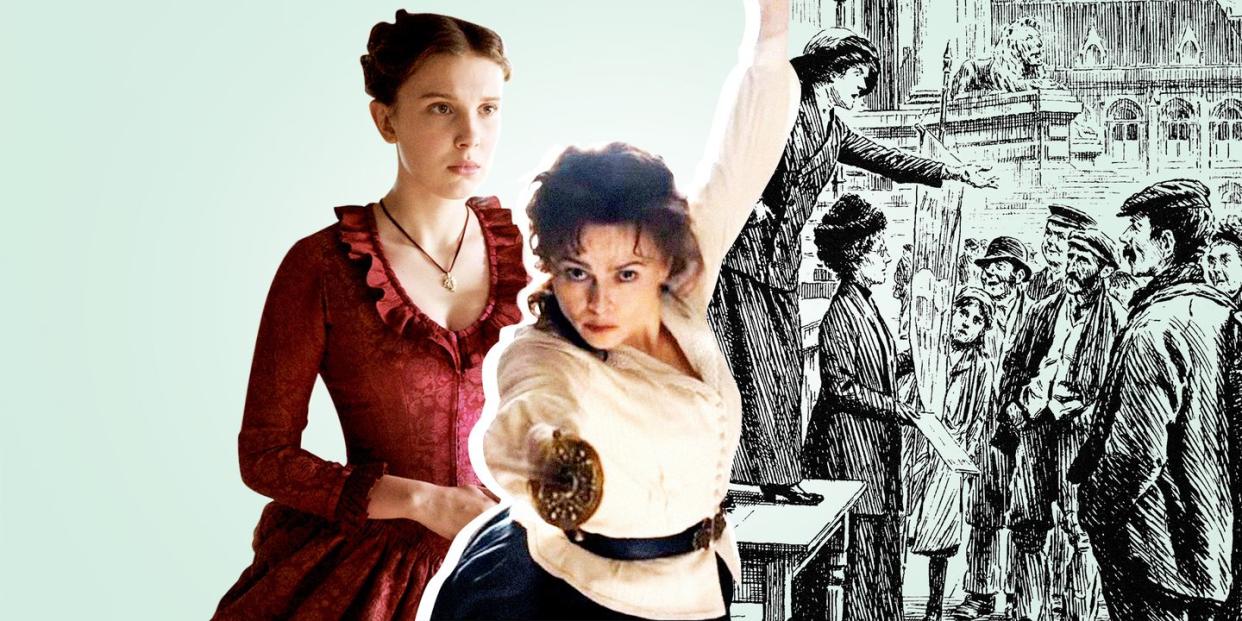Enola Holmes’ Search For Her Missing Mother Intersects With the Fight For Women’s Suffrage In the UK

Enola Holmes takes a historically misogynist franchise and flips it on it’s head by centering strong (literally—the combat scenes are no joke) female characters within a powerful feminist narrative. Netflix’s adaptation of Nancy Springer’s book series of the same name follows Sherlock Holmes’ clever younger sister Enola (Millie Bobby Brown) as she sets out on a journey to find her missing mother (Helena Bonham Carter). The film’s several mysterious plotlines converge on the issue of women’s suffrage in the United Kingdom, and although they don’t exactly line up with history, the movie references several real life figures and events.
Enola’s mother Eudoria sets the film’s plot into motion when she suddenly disappears from the secluded countryside home she and Enola live in. Enola, finding clues around her home, escapes from the care of her elder brothers Mycroft (Sam Claflin) and Sherlock (Henry Cavill)—who wish to send her off to finishing school where she will learn how to be a proper young lady—to London. On the way, she meets another young runaway, Lord Tewksbury (Louis Patridge), whom she helps evade assassination and reluctantly befriends. Tewksbury’s murder turns out to be ordered by his own grandmother, who sees his death before he replaces his late father in the House of Lords as the only way to prevent a reform bill from passing. That very bill seems to be the reason Eudoria Holmes disappeared to London, too, as her secret militant suffragette society is involved, implying that the bill in question likely has to do with women’s suffrage.
As women’s suffrage did not pass in any capacity until 1918 in the United Kingdom and Enola Holmes is set in 1884, the film doesn’t necessarily correspond with history. However, there was in fact a reform bill passed in 1884 in the UK called the Representation of the People Act 1884, or the Third Reform Act. Though this bill in particular did not directly impact women, the act extended male suffrage, paving the way for women’s suffrage which eventually followed years later. Although women over the age of 30 who met a property qualification could vote after 1918, it was only in 1928 that all women received voting rights equal to men in the UK.
There are more historical easter eggs in Eudoria’s Limehouse Lane suffragette hideout, which Enola’s deciphering leads her to in London. Among the weapons and explosives, Enola finds an activist leaflet that reads "Manchester National Society For Woman's Suffrage Public Meeting," followed by the names Amie Hicks, Gwyneth Vaughan, and Margaret McMillan. These three women were actual British suffragettes at the time—Hicks a member of Britain's first socialist party and a union organizer; Vaughan a pen name for Welsh liberal feminist writer Annie Harriet Hughes; and McMillan an activist for improved conditions for schoolchildren. These small details reinforce the potent feminist messaging of Enola Holmes.
Although the reform bill in the movie passes thanks to the vote of young Lord Tewksbury, Eudoria’s suffragette mission is still incomplete by the film’s end. Her inability to reunite with Enola yet leaves the door open for more important suffragette work to be done, perhaps by Enola herself, in a potential sequel.
You Might Also Like

